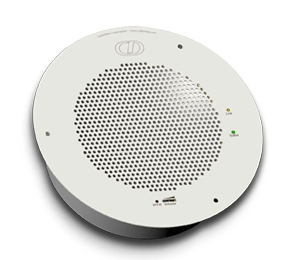011098/011099 SIP Speaker (Replacement Product is 011394)
Part Number: 011098
MSRP: $0.00
- Description
- Features
- Specs
- FAQs
- Installation
- Downloads
- SIP (RFC 3261) compatible
- Night Ringer function
- Plays audio from Multicast
- Web-based configuration
- Paging prioritization and background music
- Web-based firmware upgradeable
- External volume control
- Small footprint
- High efficiency speaker driver
- PoE 802.3af Enabled (Powered-over-Ethernet)
- IGMP l SIP endpoint or Multicast group member
- Network-adjustable speaker volume
- Peer-to-peer capable
- Can drive one ext. analog speaker for more volume
| Protocol | SIP RFC 3261 Compatible |
| Ethernet I/F | 10/100 Mbps |
| Power Input | PoE 802.3af |
| Operating Temperature | -10 degrees C to 50 degrees C (14 degrees F to 122 degrees F) |
| Payload Types | G711 A-Law and u-Law |
| Output Level | 10 Watts Peak |
| Sensitivity | 96dB / 1W / 1M S.P. Level |
| Dimensions | 9" x 2.4" |
| Warranty | 2 Year Limited |
| Part Number Standard Color | 011098, RAL 9002 Gray White (replaces 011021) |
| Part Number Optional Color | 011099, RAL 9003 Signal White |
How do I update my firmware?
Check to see if your current firmware is the latest version before attempting to update. Download the latest version firmware which includes the Update Firmware Utility. To upload the firmware from your PC, see the Upgrading the Firmware section of the VoIP V2 IP Speaker Operations Guide. See the Downloads tab.
What IP phones do you recommend for setting up a Peer to Peer with this device?
Are your speakers compliant with RFC 3261?
Yes, our speakers are compliant with RFC 3261, but not every SIP extension is fully supported such as extensions for certain phone features that our speakers do not require.
Do your speakers support other protocols?
Our speakers are SIP endpoints that use the SIP protocol in RFC 3261. Depending on the business case, we will consider custom applications using other protocols. Please contact sales@cyberdata.net for inquiries concerning other protocols.
Our IP-PBX server is RFC 3261 compliant in that it can register other SIP endpoints, so how do I create multiple paging zones using your speakers?
Our speakers do not create multiple zones as this is a feature (SIP extension) of the IP-PBX server. If your IP-PBX server does not support this SIP extension, you can use our Paging Server product to create multiple zones with our speaker.
Which IP-PBX servers do your speakers interoperate with?
Our speakers interoperate with the IP-PBX servers in the following link.
I hooked up your speakers using Asterisk and they play audio individually but why don't they play in a paging group (zone)?
1)Make sure you have installed and loaded a timing source such as Zaptel's "ztdummy" on your Asterisk server.
2) If you are using SIP phones in the same paging group as our speakers and auto-answer is activated for these phones, please upgrade to the latest paging group module in Asterisk, which is 1.2.3 or greater and put an "x" (this removes auto-answer commands our speakers do not use because they are hard-coded to auto-answer) after the extension number for the speakers in the paging group drop-down menu in FreePBX.
For additional support or answers to questions not covered on this page, who should I contact?
What are the Asterisk settings to set up our paging speakers?
For both IP Speaker and the Loudspeaker Amplifier, the settings are contained in the sip_additional.conf file in Asterisk. This file should read as follows in which "100&qot; represents the username of our speaker and the password (secret) is ext100:
[100] username=100 type=friend secret=ext100 record_out=Adhoc record_in=Adhoc qualify=no port=5060 nat=never mailbox=100@device host=dynamic dtmfmode=rfc2833 context=from-internal canreinvite=no callerid=100 <100>
How do I set up a page group in Asterisk?
Page groups are found in the extensions_additional.conf file in Asterisk. The paging group portion of this file should read as follows in which "101 and 102" are the usernames and extensions of two speakers and "103" is the extension used to call the paging group of speakers 101 and 102, and "105" is the extension to call speakers 101,102, and 104:
[ext-paging] include => ext-paging-custom exten => PAGE102,1,GotoIf($[ ${CALLERID(number)} = 102 ]?skipself) exten => PAGE102,n,Dial(SIP/102,5) exten => PAGE102,n(skipself),Noop(Not paging originator) exten => PAGE101,1,GotoIf($[ ${CALLERID(number)} = 101 ]?skipself) exten => PAGE101,n,Dial(SIP/101,5) exten => PAGE101,n(skipself),Noop(Not paging originator) exten => PAGE104,1,GotoIf($[ ${CALLERID(number)} = 104 ]?skipself) exten => PAGE104,n,Dial(SIP/104,5) exten => PAGE104,n(skipself),Noop(Not paging originator) exten => Debug,1,Noop(dialstr is LOCAL/PAGE102@ext-paging&LOCAL/PAGE101@ext-paging) exten => Debug,n,Noop(dialstr is LOCAL/PAGE104@ext-paging&LOCAL/PAGE102@ext-paging&LOCAL/PAGE101@ext-paging) exten => 103,1,Page(LOCAL/PAGE102@ext-paging&LOCAL/PAGE101@ext-paging) exten => 105,1,Page(LOCAL/PAGE104@ext-paging&LOCAL/PAGE102@ext-paging&LOCAL/PAGE101@ext-paging)
; end of [ext-paging]
Are you able to traverse the NAT with your IP paging products?
Our IP paging products are programmed to traverse the NAT using Session Border Controllers (SBCs) of the VoIP hosting company or service provider. The SBCs act as an outbound proxy and manage the SIP traffic between the SIP server and the SIP endpoint behind the NAT. For more information on SBCs, go here.
How do I configure Music-on-Hold (MOH) for Asterisk?
Use the instructions at the following link to set up MOH for Asterisk:
http://www.voip-info.org/wiki-Asterisk+config+musiconhold.conf
We would like to communicate directly to your products. Do you have any open source programs you can recommend to do this?
Yes. Try the following links and also contact CyberData support for help Data format: RTP audio 8k G.711 a/u Law 20ms packet time Open source programs:
MAST
http://www.aelius.com/njh/mast/
MAST can handle ulaw and alaw as well as streaming from a mic to a speaker.
Linphone:
http://www.linphone.org/index.php/eng
Linphone has a test application called rtpsend that streams data out as ulaw by default. (It may be trivial to modify this to send in other formats).
What type of files can I send to the IP Speaker in Multicast mode?
| G711 u-Law or A-law |
| 8 bit |
| 8000 hz |
| 160 byte packets every 20ms |
After a period of time, my device stops working or is unreachable.
This is a common problem when the re-registration time value is not set correctly.
On our device, you need to make sure that the re-registration time value (in minutes) is less than that is set on the IP-PBX server.
On an Asterisk-based VoIP SIP PBX system, the CyberData SIP Device status is "Busy" or "Unreachable". I have set up both the CyberData VoIP SIP device and the PBX extension information for the device. I can see the device on the network, am able to PING it, and can bring up the device web page with a browser. However, when I try to call it from a phone extension, I see the word "Busy" or "Unreachable" in the Asterisk log.
In the PBX setup page for the extension of the CyberData device, find the Qualify= value and change it to NO. If the Qualify= value requires a numeric value, then change it to 0.
Note that on some Asterisk systems (such as Intuitive Voice) this value is called the Heartbeat= value. Set the Heartbeat= value to NO, and then save the settings.
Also, on the product's SIP Setup page, make sure that the Register Expiration (minutes) setting is set to less than 6 minutes (5 minutes is good) because it needs to be a value less than the Asterisk default value of 6 minutes. Save the settings after changing the Register Expiration (minutes) setting.
I upgraded my 3CX PBX server to 7.1 and now my Rev B CyberData VoIP IP Speaker and My VoIP Paging Amplifier do not stay registered with the server.
There is a 3CX version 7.1 registration / timing bug. To correct this problem, complete the following steps:
1. Log into the 3CX PBX system, and select SETTINGS -> ADVANCED -> CUSTOM PARAMETERS.
2. Scroll down to select the NONCEEXPIRATION parameter.
3. Change the NONCEEXPIRATION value from 1 to 2 and save the changes.
Note: There are pictures of the 3CX PBX pages and parameters at the end of the document at this link.
I see in the electrical connection diagram in the users guide that there is a High PIV Ultra Fast switching diode. Do I need it and if so do you have a source?
This High PIV Ultra Fast switching diode prevents CEMF kick back from an intermediary relay coil when power is cut and the coil field collapses. You could use an On-Semi MUR105 diode.
| Specifications Datasheet | ||
| Digi-Key Part Ordering |
|
I have a speaker used for multicast paging. How can I also set it up as a night ringer extension?
See Section 2.3.3, "Night Ringer Setup" in the V2 Speaker Operations Guide (Downloads tab).
The CyberData device connected to a Dell Powerconnect 3524P or 3548P port did not stay linked up. The device comes up, and then it goes down, and then it comes up cycling. If connected to a Linksys SRW208MP switch, the CyberData device stays up.
Pantel, Cisco, or Linksys PoE endpoints all work on the Dell Powerconnect 3524P.
A user tried hard coding the switch speed/duplex and tried four different Dell Powerconnect 3524P switches. --- Check to make sure the Dell Powerconnect 3524P has flow control enabled on the port for the CyberData device to power up properly.
According to Dell: Flow Control Support (IEEE 802.3X): Flow control enables lower speed devices to communicate with higher speed devices by requesting that the higher speed device refrains from sending packets. Transmissions are temporarily halted to prevent buffer overflows. For information on configuring Flow Control for ports or LAGs, see "Defining Port Configuration" or "Defining LAG Parameters" in the Dell© PowerConnect© 35xx Systems User's Guide.
Are there a set of specs. or standards that define proper spacing for your IP Speakers? We need to determine the proper number of speakers for our buildings' corridors. I am looking for something that considers ceiling height and room size/shape to suggest the appropriate quantity. The speaker calculator on your website seems sufficient for square rooms. It is hallways that I am struggling with. The hallways measure 9 feet x 9 feet by 100-150 feet in length.
In a ceiling mount, you would want about 1 per every 10-15 feet of hallway length.
If you used the paging amp you could use 3 paging amps per 100 feet as per this drawing.
This assumes average ambient noise and surface attenuation levels.
The following figure shows the 011061 V2 Paging Amp and the 011068 Horn Loudspeaker:

I am unable to connect with the unit when it is plugged into a Cisco SLM 224P switch.
The cables or switch ports that you are connecting to are set in switch or hub mode instead of endpoint stations. The MDIX setting needs to be changed to MDI since our VoIP products are end stations.
From the Cisco SLM 224P User Guide:
Change to MDI:
MDI / MDIX Â Displays the Media Dependent Interface (MDI) / Media Dependent Interface with Crossover (MDIX) status on the port. Hubs and switches are deliberately wired the opposite of the way end stations are wired, so that when a hub or switch is connected to an end station, a straight through Ethernet cable can be used, and the pairs are matched up properly. When two hubs or switches are connected to each other, or two end stations are connected to each other, a crossover cable is used to ensure that the correct pairs are connected. The possible field values are:
MDIX Â Use for hubs and switches. MDI Â Use for end stations.I have a Cisco 6513 switch. When I plug in a CyberData VoIP device, the device constantly reboots and will not register to the SIP server.
Please adjust the switch power selection to Power inline static, as opposed to Power inline dynamic. This will allow the device to continuously receive 15.4W of power.
We have registered the V2 IP Speaker on Cisco Call Manager but are unable to register the V2 IP Speaker's Nightringer using the V2 IP Speaker's MAC address. How do I configure two extensions on Call Manager for the V2 IP Speaker?
Create a second directory number and user for the Nightringer extension. You may need to fudge a digit of the MAC Address so that Call Manager allows you to associate it to the new user. Be sure this MAC address does not match any other CyberData devices on your network.
I have a Cisco Catalyst series switch. How do I set the unit so that it can use PoE (under 15.4w) instead of an external power source?
There are known PoE limitations with third party devices on the Cisco Catalyst series switches. This includes the 2500, 3500, and 6500 series switches.
Its important to keep in mind that CyberData devices are considered third party devices and require switch port setting adjustments.
Be sure to turn power policing off if it has been enabled on your switch. Power policing is disabled by default. Also, configure your port for no shutdown.
Use the following command to configure inline power: power inline static max 15400
Typical Installation

AC Power
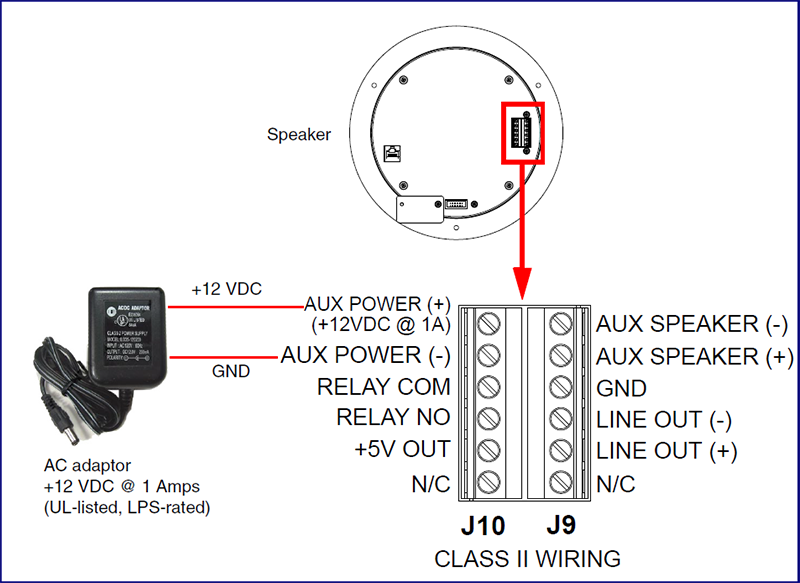
LED Strobe
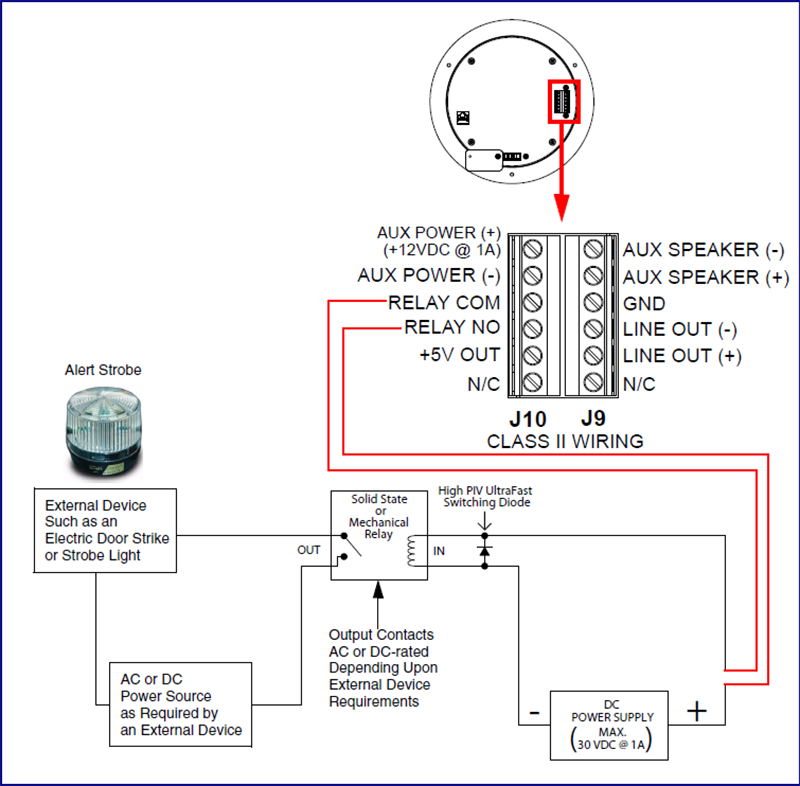
Auxilliary Analog Speaker
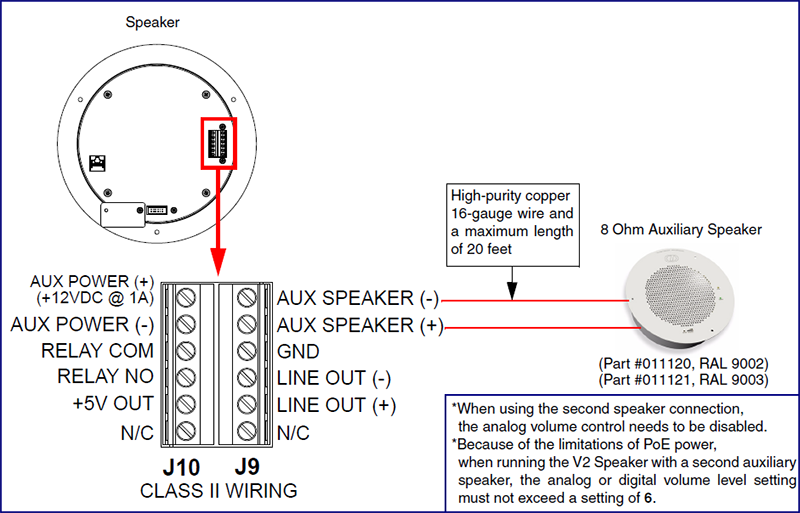
Amplifier
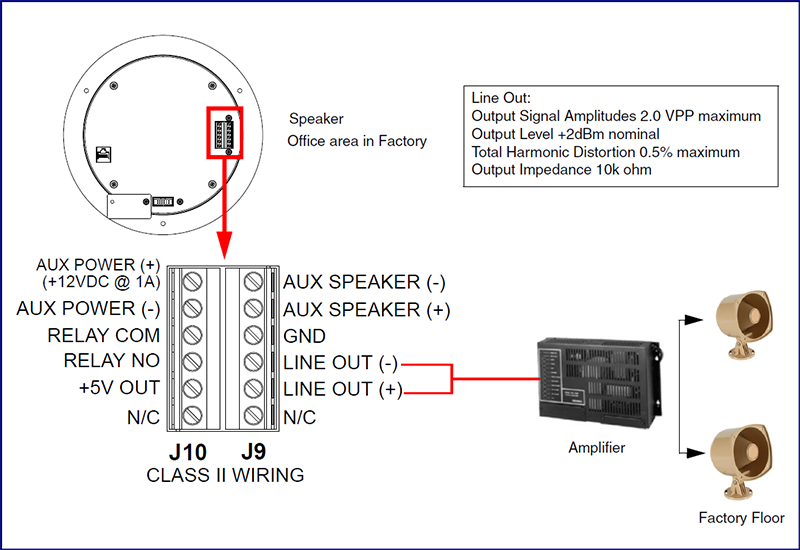
Ceiling Mounting
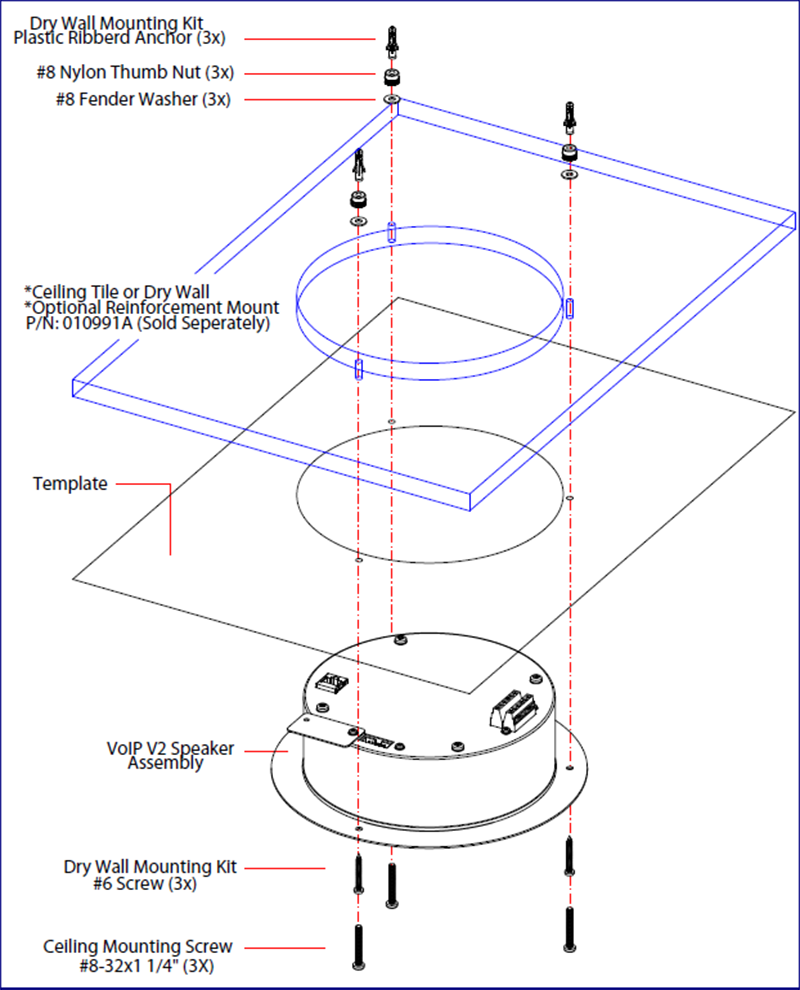
Mounting Bracket
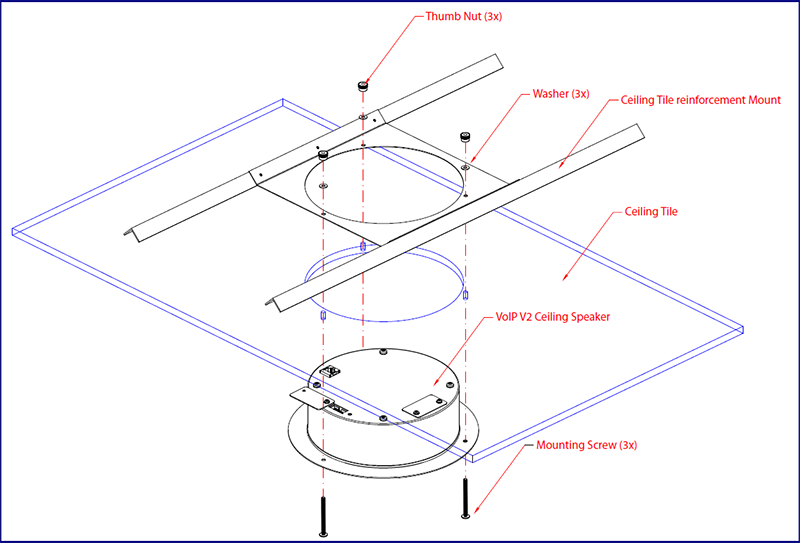
Description
Features
- SIP (RFC 3261) compatible
- Night Ringer function
- Plays audio from Multicast
- Web-based configuration
- Paging prioritization and background music
- Web-based firmware upgradeable
- External volume control
- Small footprint
- High efficiency speaker driver
- PoE 802.3af Enabled (Powered-over-Ethernet)
- IGMP l SIP endpoint or Multicast group member
- Network-adjustable speaker volume
- Peer-to-peer capable
- Can drive one ext. analog speaker for more volume
Specs
| Protocol | SIP RFC 3261 Compatible |
| Ethernet I/F | 10/100 Mbps |
| Power Input | PoE 802.3af |
| Operating Temperature | -10 degrees C to 50 degrees C (14 degrees F to 122 degrees F) |
| Payload Types | G711 A-Law and u-Law |
| Output Level | 10 Watts Peak |
| Sensitivity | 96dB / 1W / 1M S.P. Level |
| Dimensions | 9" x 2.4" |
| Warranty | 2 Year Limited |
| Part Number Standard Color | 011098, RAL 9002 Gray White (replaces 011021) |
| Part Number Optional Color | 011099, RAL 9003 Signal White |
FAQs
How do I update my firmware?
Check to see if your current firmware is the latest version before attempting to update. Download the latest version firmware which includes the Update Firmware Utility. To upload the firmware from your PC, see the Upgrading the Firmware section of the VoIP V2 IP Speaker Operations Guide. See the Downloads tab.
What IP phones do you recommend for setting up a Peer to Peer with this device?
Are your speakers compliant with RFC 3261?
Yes, our speakers are compliant with RFC 3261, but not every SIP extension is fully supported such as extensions for certain phone features that our speakers do not require.
Do your speakers support other protocols?
Our speakers are SIP endpoints that use the SIP protocol in RFC 3261. Depending on the business case, we will consider custom applications using other protocols. Please contact sales@cyberdata.net for inquiries concerning other protocols.
Our IP-PBX server is RFC 3261 compliant in that it can register other SIP endpoints, so how do I create multiple paging zones using your speakers?
Our speakers do not create multiple zones as this is a feature (SIP extension) of the IP-PBX server. If your IP-PBX server does not support this SIP extension, you can use our Paging Server product to create multiple zones with our speaker.
Which IP-PBX servers do your speakers interoperate with?
Our speakers interoperate with the IP-PBX servers in the following link.
I hooked up your speakers using Asterisk and they play audio individually but why don't they play in a paging group (zone)?
1)Make sure you have installed and loaded a timing source such as Zaptel's "ztdummy" on your Asterisk server.
2) If you are using SIP phones in the same paging group as our speakers and auto-answer is activated for these phones, please upgrade to the latest paging group module in Asterisk, which is 1.2.3 or greater and put an "x" (this removes auto-answer commands our speakers do not use because they are hard-coded to auto-answer) after the extension number for the speakers in the paging group drop-down menu in FreePBX.
For additional support or answers to questions not covered on this page, who should I contact?
What are the Asterisk settings to set up our paging speakers?
For both IP Speaker and the Loudspeaker Amplifier, the settings are contained in the sip_additional.conf file in Asterisk. This file should read as follows in which "100&qot; represents the username of our speaker and the password (secret) is ext100:
[100] username=100 type=friend secret=ext100 record_out=Adhoc record_in=Adhoc qualify=no port=5060 nat=never mailbox=100@device host=dynamic dtmfmode=rfc2833 context=from-internal canreinvite=no callerid=100 <100>
How do I set up a page group in Asterisk?
Page groups are found in the extensions_additional.conf file in Asterisk. The paging group portion of this file should read as follows in which "101 and 102" are the usernames and extensions of two speakers and "103" is the extension used to call the paging group of speakers 101 and 102, and "105" is the extension to call speakers 101,102, and 104:
[ext-paging] include => ext-paging-custom exten => PAGE102,1,GotoIf($[ ${CALLERID(number)} = 102 ]?skipself) exten => PAGE102,n,Dial(SIP/102,5) exten => PAGE102,n(skipself),Noop(Not paging originator) exten => PAGE101,1,GotoIf($[ ${CALLERID(number)} = 101 ]?skipself) exten => PAGE101,n,Dial(SIP/101,5) exten => PAGE101,n(skipself),Noop(Not paging originator) exten => PAGE104,1,GotoIf($[ ${CALLERID(number)} = 104 ]?skipself) exten => PAGE104,n,Dial(SIP/104,5) exten => PAGE104,n(skipself),Noop(Not paging originator) exten => Debug,1,Noop(dialstr is LOCAL/PAGE102@ext-paging&LOCAL/PAGE101@ext-paging) exten => Debug,n,Noop(dialstr is LOCAL/PAGE104@ext-paging&LOCAL/PAGE102@ext-paging&LOCAL/PAGE101@ext-paging) exten => 103,1,Page(LOCAL/PAGE102@ext-paging&LOCAL/PAGE101@ext-paging) exten => 105,1,Page(LOCAL/PAGE104@ext-paging&LOCAL/PAGE102@ext-paging&LOCAL/PAGE101@ext-paging)
; end of [ext-paging]
Are you able to traverse the NAT with your IP paging products?
Our IP paging products are programmed to traverse the NAT using Session Border Controllers (SBCs) of the VoIP hosting company or service provider. The SBCs act as an outbound proxy and manage the SIP traffic between the SIP server and the SIP endpoint behind the NAT. For more information on SBCs, go here.
How do I configure Music-on-Hold (MOH) for Asterisk?
Use the instructions at the following link to set up MOH for Asterisk:
http://www.voip-info.org/wiki-Asterisk+config+musiconhold.conf
We would like to communicate directly to your products. Do you have any open source programs you can recommend to do this?
Yes. Try the following links and also contact CyberData support for help Data format: RTP audio 8k G.711 a/u Law 20ms packet time Open source programs:
MAST
http://www.aelius.com/njh/mast/
MAST can handle ulaw and alaw as well as streaming from a mic to a speaker.
Linphone:
http://www.linphone.org/index.php/eng
Linphone has a test application called rtpsend that streams data out as ulaw by default. (It may be trivial to modify this to send in other formats).
What type of files can I send to the IP Speaker in Multicast mode?
| G711 u-Law or A-law |
| 8 bit |
| 8000 hz |
| 160 byte packets every 20ms |
After a period of time, my device stops working or is unreachable.
This is a common problem when the re-registration time value is not set correctly.
On our device, you need to make sure that the re-registration time value (in minutes) is less than that is set on the IP-PBX server.
On an Asterisk-based VoIP SIP PBX system, the CyberData SIP Device status is "Busy" or "Unreachable". I have set up both the CyberData VoIP SIP device and the PBX extension information for the device. I can see the device on the network, am able to PING it, and can bring up the device web page with a browser. However, when I try to call it from a phone extension, I see the word "Busy" or "Unreachable" in the Asterisk log.
In the PBX setup page for the extension of the CyberData device, find the Qualify= value and change it to NO. If the Qualify= value requires a numeric value, then change it to 0.
Note that on some Asterisk systems (such as Intuitive Voice) this value is called the Heartbeat= value. Set the Heartbeat= value to NO, and then save the settings.
Also, on the product's SIP Setup page, make sure that the Register Expiration (minutes) setting is set to less than 6 minutes (5 minutes is good) because it needs to be a value less than the Asterisk default value of 6 minutes. Save the settings after changing the Register Expiration (minutes) setting.
I upgraded my 3CX PBX server to 7.1 and now my Rev B CyberData VoIP IP Speaker and My VoIP Paging Amplifier do not stay registered with the server.
There is a 3CX version 7.1 registration / timing bug. To correct this problem, complete the following steps:
1. Log into the 3CX PBX system, and select SETTINGS -> ADVANCED -> CUSTOM PARAMETERS.
2. Scroll down to select the NONCEEXPIRATION parameter.
3. Change the NONCEEXPIRATION value from 1 to 2 and save the changes.
Note: There are pictures of the 3CX PBX pages and parameters at the end of the document at this link.
I see in the electrical connection diagram in the users guide that there is a High PIV Ultra Fast switching diode. Do I need it and if so do you have a source?
This High PIV Ultra Fast switching diode prevents CEMF kick back from an intermediary relay coil when power is cut and the coil field collapses. You could use an On-Semi MUR105 diode.
| Specifications Datasheet | ||
| Digi-Key Part Ordering |
|
I have a speaker used for multicast paging. How can I also set it up as a night ringer extension?
See Section 2.3.3, "Night Ringer Setup" in the V2 Speaker Operations Guide (Downloads tab).
The CyberData device connected to a Dell Powerconnect 3524P or 3548P port did not stay linked up. The device comes up, and then it goes down, and then it comes up cycling. If connected to a Linksys SRW208MP switch, the CyberData device stays up.
Pantel, Cisco, or Linksys PoE endpoints all work on the Dell Powerconnect 3524P.
A user tried hard coding the switch speed/duplex and tried four different Dell Powerconnect 3524P switches. --- Check to make sure the Dell Powerconnect 3524P has flow control enabled on the port for the CyberData device to power up properly.
According to Dell: Flow Control Support (IEEE 802.3X): Flow control enables lower speed devices to communicate with higher speed devices by requesting that the higher speed device refrains from sending packets. Transmissions are temporarily halted to prevent buffer overflows. For information on configuring Flow Control for ports or LAGs, see "Defining Port Configuration" or "Defining LAG Parameters" in the Dell© PowerConnect© 35xx Systems User's Guide.
Are there a set of specs. or standards that define proper spacing for your IP Speakers? We need to determine the proper number of speakers for our buildings' corridors. I am looking for something that considers ceiling height and room size/shape to suggest the appropriate quantity. The speaker calculator on your website seems sufficient for square rooms. It is hallways that I am struggling with. The hallways measure 9 feet x 9 feet by 100-150 feet in length.
In a ceiling mount, you would want about 1 per every 10-15 feet of hallway length.
If you used the paging amp you could use 3 paging amps per 100 feet as per this drawing.
This assumes average ambient noise and surface attenuation levels.
The following figure shows the 011061 V2 Paging Amp and the 011068 Horn Loudspeaker:

I am unable to connect with the unit when it is plugged into a Cisco SLM 224P switch.
The cables or switch ports that you are connecting to are set in switch or hub mode instead of endpoint stations. The MDIX setting needs to be changed to MDI since our VoIP products are end stations.
From the Cisco SLM 224P User Guide:
Change to MDI:
MDI / MDIX Â Displays the Media Dependent Interface (MDI) / Media Dependent Interface with Crossover (MDIX) status on the port. Hubs and switches are deliberately wired the opposite of the way end stations are wired, so that when a hub or switch is connected to an end station, a straight through Ethernet cable can be used, and the pairs are matched up properly. When two hubs or switches are connected to each other, or two end stations are connected to each other, a crossover cable is used to ensure that the correct pairs are connected. The possible field values are:
MDIX Â Use for hubs and switches. MDI Â Use for end stations.I have a Cisco 6513 switch. When I plug in a CyberData VoIP device, the device constantly reboots and will not register to the SIP server.
Please adjust the switch power selection to Power inline static, as opposed to Power inline dynamic. This will allow the device to continuously receive 15.4W of power.
We have registered the V2 IP Speaker on Cisco Call Manager but are unable to register the V2 IP Speaker's Nightringer using the V2 IP Speaker's MAC address. How do I configure two extensions on Call Manager for the V2 IP Speaker?
Create a second directory number and user for the Nightringer extension. You may need to fudge a digit of the MAC Address so that Call Manager allows you to associate it to the new user. Be sure this MAC address does not match any other CyberData devices on your network.
I have a Cisco Catalyst series switch. How do I set the unit so that it can use PoE (under 15.4w) instead of an external power source?
There are known PoE limitations with third party devices on the Cisco Catalyst series switches. This includes the 2500, 3500, and 6500 series switches.
Its important to keep in mind that CyberData devices are considered third party devices and require switch port setting adjustments.
Be sure to turn power policing off if it has been enabled on your switch. Power policing is disabled by default. Also, configure your port for no shutdown.
Use the following command to configure inline power: power inline static max 15400
Installation
Typical Installation

AC Power

LED Strobe

Auxilliary Analog Speaker

Amplifier

Ceiling Mounting

Mounting Bracket

Downloads



